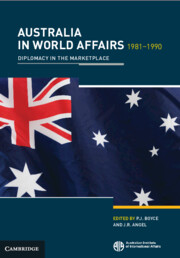Book contents
- Frontmatter
- Contents
- Preface
- Introduction
- Part 1 Australia and the World
- Part 2 Australia and the Regions
- 7 Australia and the United States
- 8 Australia and Southeast Asia
- 9 Australia and the South Pacific
- 10 Australia and the United Kingdom
- 11 Australia and Western Europe
- 12 Australia and the Eastern Bloc
- 13 Australia’s relations with Japan and the Korean Peninsula
- 14 Australia and China
- 15 The Commonwealth connection: a contemporary history and prospect
- Index
12 - Australia and the Eastern Bloc
from Part 2 - Australia and the Regions
Published online by Cambridge University Press: 29 March 2024
- Frontmatter
- Contents
- Preface
- Introduction
- Part 1 Australia and the World
- Part 2 Australia and the Regions
- 7 Australia and the United States
- 8 Australia and Southeast Asia
- 9 Australia and the South Pacific
- 10 Australia and the United Kingdom
- 11 Australia and Western Europe
- 12 Australia and the Eastern Bloc
- 13 Australia’s relations with Japan and the Korean Peninsula
- 14 Australia and China
- 15 The Commonwealth connection: a contemporary history and prospect
- Index
Summary
The relationship between Australia and the Soviet Union and its allies in Eastern Europe has been characterised by considerable distrust. The isolation and fear of the danger posed by hostile powers was a recurrent theme in the consciousness of colonial Australians, a fear which took a precise Russian focus at the time of the Crimean War, the British–Russian tensions in the second half of the nineteenth century, and the establishment of a Russian Pacific fleet based at Vladivostok. A whole infrastructure of distrust stemming from the 1917 revolution and the perceived expansionist aims of the Bolshevik government was built upon this historical basis. This feeling, shared by much of the Western world, was stimulated enormously by the Cold War and by the effect on public debate in Australia of the large number of articulate refugees from both the Soviet Union and those states of Eastern Europe which were part of the Soviet orbit. This prevailing sense of distrust has structured the Australian approach to the Soviet Union and its allies throughout the postwar period.
Keywords
- Type
- Chapter
- Information
- Australia in World Affairs 1981–1990Diplomacy in the Marketplace, pp. 225 - 245Publisher: Cambridge University PressFirst published in: 2024



